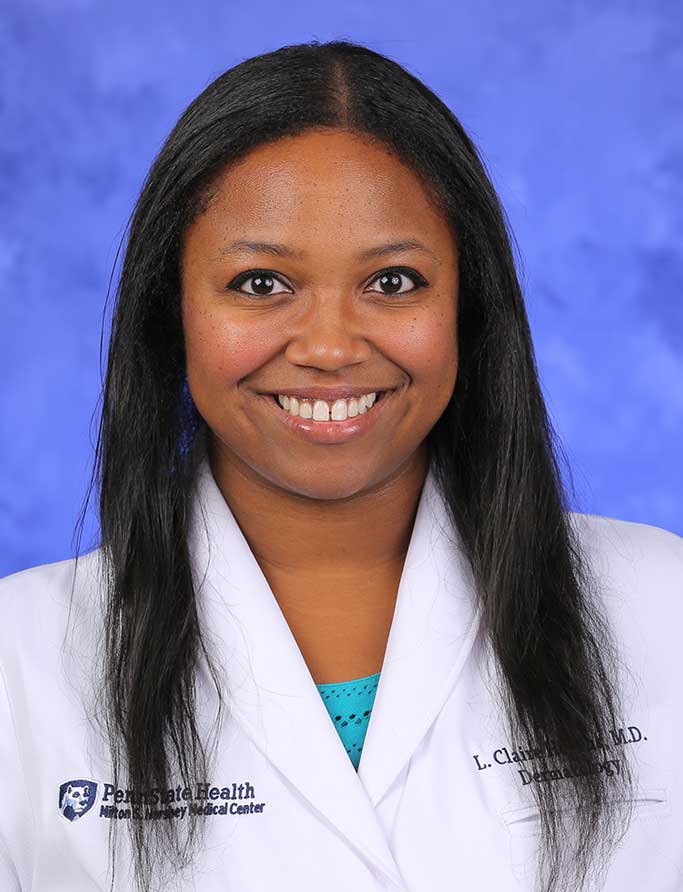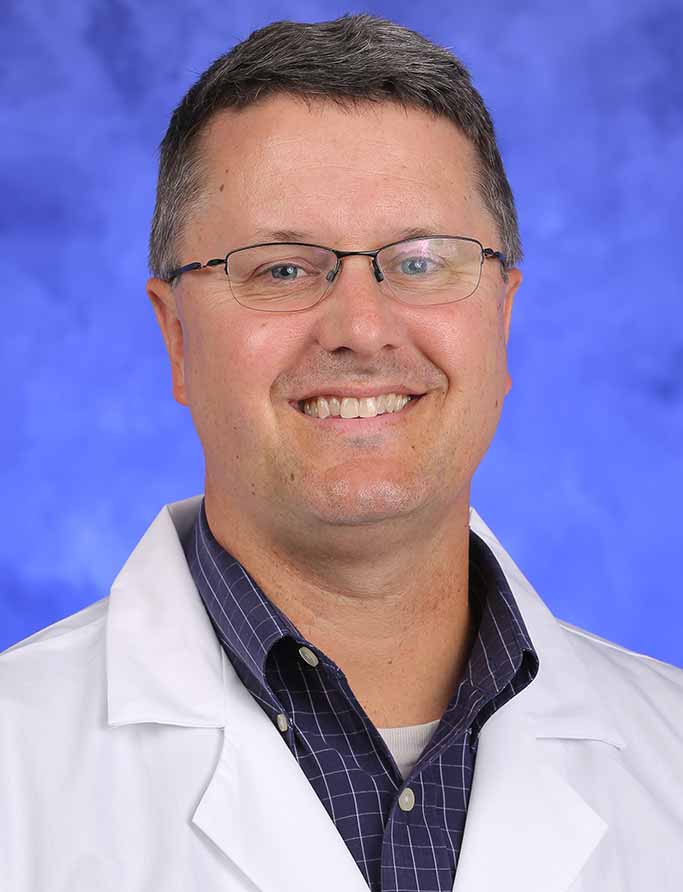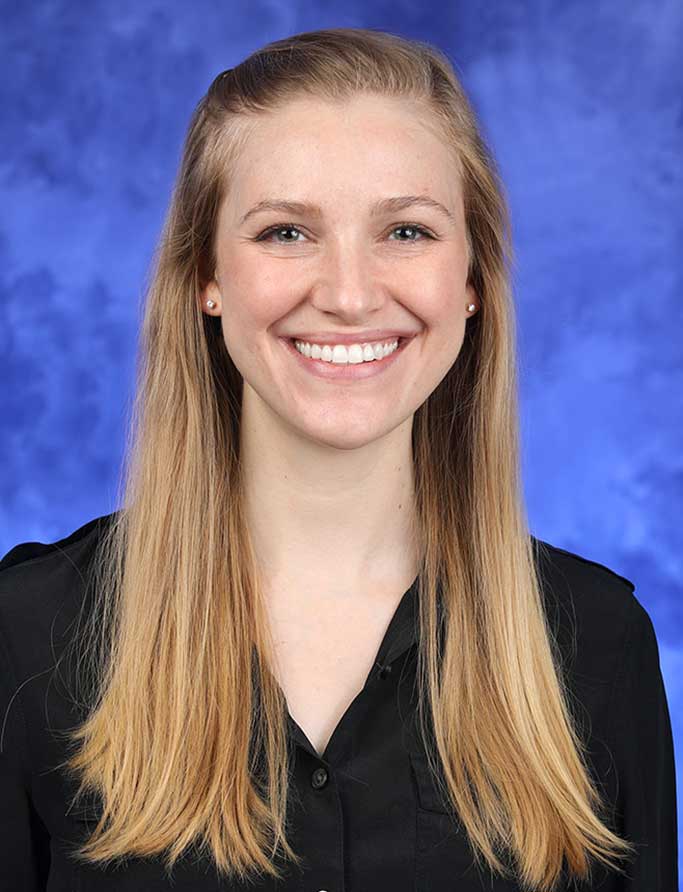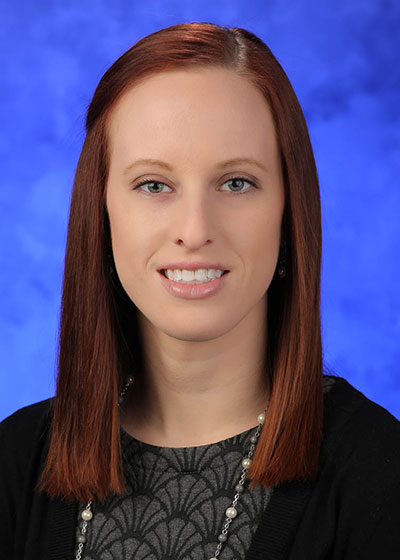Jump to topic
Search
Program Details
Penn State Health’s accredited Dermatology Residency was started in 1982 and accepts four residents each year in the general dermatology track.
The advanced program begins in the PGY-2 year after one year of prerequisite training in internal medicine, general surgery, family practice, obstetrics and gynecology, pediatrics or emergency medicine. The prerequisite year can be done at Penn State College of Medicine or any ACGME-approved program. For these preliminary disciplines, applicants will be required to submit a separate ERAS application in addition to the specialty application.
An ABD-approved physician-scientist training track, added in 2011, is open to accepted residents in the latter part of their first year of residency and incorporates an additional year of basic and translational research following the PGY-4 (third year of residency).
– David C. Leach, MD
Residents come from a wide variety of medical schools in the United States and internationally. After completing their training at Penn State Health Milton S. Hershey Medical Center, residents have done fellowships in dermatopathology, procedural dermatology and pediatric dermatology. They have entered private practice and academic dermatology as general dermatologists or sub-specialists within dermatology. Learn about current residents here and see details on past residents here. The program offers a strong environment to support health services, translational and basic science research. A variety of teaching conferences are held each week, and clinical training is closely supervised. In addition, each resident is asked to participate in some type of investigative project during their three years in the program. Penn State Health Dermatology strives to have the best faculty and best residents learning in a challenging, yet nurturing environment.
Learn More about the Residency
See details on the VSLO application process here.
When applying through VSLO for Penn State Dermatology, under the Biographic Information section, students should submit a robust bio sketch of their interest in Dermatology, interest in Penn State and any related accomplishments.
Communication with the program
The Dermatology Residency will be following the below APD standardized guidelines about communication with programs:
Before and during interview season, applicants are asked to refrain from contacting programs to express interest or provide application updates prior to interviews, except in truly exceptional circumstances (e.g. couples matching updates, major life events that impact preferences). Questions about a program that cannot be easily answered by available materials (website, social media, etc.) can be directed to the program.
Post-interview communication of preference – including “letters of intent” and thank you letters – should not be sent to programs. These types of communication are typically not used by residency programs in decision-making and lead to downstream pressures on applicants.
Application Requirements
The program interviews senior medical students and candidates who have completed their PGY-1 year as well as applicants with training beyond this. In addition to the application and requested letters of recommendation, a copy of a dean’s letter and transcript is required for each applicant.
All applications must be submitted through ERAS and must include:
- Common application form (CAF)
- Personal statements
- Transcripts
- MSPE/dean’s letter
- Letters of recommendation (at least three; maximum of four); The program recommends that at least one letter of recommendation come from a dermatology faculty member and suggests that other letters come from non-dermatology faculty who can speak to the applicant’s attributes, skills and achievements.
- USMLE Step 1 transcript
My ERAS application
Application review
- The program will holistically review applications and is interested in each applicant’s goals, interests and experiences.
- The program will not screen applications for Step 1 or Step 2 scores, nor are these required for offers of interviews.
The program receives more than 600 applicants, interviews 35 to 40 and accepts four residents per year. The National Residents Matching Program, NRMP, is the only method utilized for the match process. Visit the ERAS website for details, or email erashelp@aamc.org.
Application Deadline
Applications and supporting materials should be submitted and completed in ERAS by Oct. 1. Applications or supporting documents by mail or email will not be accepted.
Interviews
The program will contact applicants via ERAS to schedule interviews; a response within 48 hours is expected, and if no response is received, the program will conclude non-interest. Interviews take place in early December each year.
The 2023-2024 interviews will take place virtually on Dec. 6 and 8, 2023, for our Dermatology (Advanced) track and December 7, 2023, for our Derm-Community Health (Advanced) track. The program will be participating in the first round of coordinated interview releases on Nov. 6, with an expected response date by Nov. 9.
The program understands that the application process is stressful and does its best to accommodate candidate scheduling needs. Therefore, applicants are strongly advised to let the program know of any requests for a change in interview date. The program strongly disapproves of the provision or receipt of compensation (including reimbursement) for interview swaps between applicants. Monetary incentives can increase disparities between applicants, allowing for opportunities that are not possible for everyone. Therefore, the program has a zero-tolerance policy for this behavior, and will revoke interview invitations for applicants who provide or receive compensation for interview swaps at any program.
Community Health Track
We are pleased to announce that for the 2024 ERAS cycle, we will be increasing our match quota by 1 to recruit a resident into our new Community Health Track.
Penn State Health has a mission to continually improve the health and well-being of the people of Pennsylvania and beyond with excellent, compassionate and culturally responsive and equitable care. The goals of this track are to:
- develop competent and compassionate physicians/dermatologists,
- reach underserved and marginalized populations in central PA,
- interest underrepresented in medicine students to pursue a field in dermatology, and
- create longitudinal change in our community by providing patient care and by completing a capstone project during their residency.
This resident will work alongside our faculty and other residents but will also have the opportunity to have dedicated time to go offsite to serve the community in need.
If interested, please apply through our separate ID numbers:
- ERAS ID: Derm-Community Health
- NRMP ID: 1617080A2
You are welcome to apply to one or both of our tracks.
What Alumni Have to Say
Past Residents
Virtual Tour
Penn State Health
Penn State Health is a multi-hospital health system serving patients and communities across 29 counties of Pennsylvania. Its mission is to improve health through patient care, research, education and community outreach.
In December 2017, the system partnered with Highmark Health to facilitate creation of a value-based, community care network in the region. The shared goal of Highmark and Penn State Health is to ensure patients in the community are within:
- 10 minutes of a Penn State Health primary care provider
- 20 minutes of Penn State Health specialty care
- 30 minutes of a Penn State Health acute care facility
Learn more about Penn State Health

Penn State Health Children’s Hospital (left), Penn State Health Milton S. Hershey Medical Center (center) and Penn State Cancer Institute (right)
Penn State Health Milton S. Hershey Medical Center
500 University Dr., Hershey, Pa., 17033 (Derry Township, Dauphin County)
- The health system’s 647-bed flagship teaching and research hospital
- The only medical facility in Pennsylvania accredited as both an adult and a pediatric Level I (highest-level) trauma center
- Dedicated surgical, neuroscience, cardiovascular, trauma and medical intensive care units
- Accredited Life Lion critical-care transport providing more than 1,100 helicopter and approximately 750 ground ambulance transports per year
- More than 1,300 faculty members and more than 650 residents and fellows
- Approximately 29,000 admissions, 73,000 emergency department visits, 1.1 million outpatient visits and 33,000 surgical procedures annually
- Designated as a Magnet hospital since 2007
Learn more about Milton S. Hershey Medical Center
Penn State Health Children’s Hospital
600 University Dr., Hershey, Pa. 17033 (Derry Township, Dauphin County)
- An eight-story, 263,000-square-foot-facility built in 2013 and expanded in 2020
- 146 licensed pediatric beds, 18 acute care beds and a 56-bed neonatal intensive care unit
- Level IV (highest-level) neonatal intensive care unit
- Level I quaternary (highest-level) pediatric intensive care unit
- Level I (highest-level) pediatric trauma center designation
- Intermediate care unit
- Dedicated pediatric operating rooms
- More than 150,000 pediatric outpatient visits and approximately 5,000 pediatric patient discharges annually
Welcome to Hershey
More About Hershey
Interested in learning more about living and working in Hershey, Pa.? See details here:
Wellness, including emotional, spiritual, social and physical health, is a crucial component to training and to becoming a professional, compassionate and resilient physician. Self-care is a skill which must be continually practiced and reinforced. Penn State College of Medicine and Penn State Health are committed to addressing wellness among residents and fellows, with multiple resources readily available.
Institutional resources
- Visit BeWell – a health program designed to support Penn State Health employees
- See Penn State College of Medicine wellness resources here
- Employee Health Care Concierge and Case Management Service
- Partners in Medicine
Moving to a new city with your family does not have to be stressful. Our residency program has assisted many significant others with finding employment. There is also a GME-Wide Partners in Medicine (PIM) group that offers networking opportunities as well as various social and community oriented activities. - The Doctors Kienle Center for Humanistic Medicine
Graduate medical education resources
Institutional Resources
Penn State Health and Penn State College of Medicine celebrate, embrace and support the diversity of all patients, faculty, staff, students and trainees.
Office for Diversity, Equity and Inclusion
In keeping with this, Penn State Health has an active Office for Diversity, Equity and Inclusion with various programs, networks and resource groups, including:
- Talks and lectures on diversity, equity and inclusion through the Inclusion Academy
- Regular events on topics such as eradicating racism and creating a culture of inclusiveness
- Many Business Employee Resource Groups (BERGs), including:
- Disability Business Employee Resource Group
- Interfaith Business Employee Resource Group
- LGBTQ+ Business Employee Resource Group
- Military and Veterans Business Employee Resource Group
- Multicultural Business Employee Resource Group
- NextGen Business Employee Resource Group
Learn more about the Penn State Health Office for Diversity, Equity and Inclusion
Learn more about the College of Medicine’s Office for Diversity, Equity and Belonging
Office for Culturally Responsive Health Care Education
The vision at Penn State College of Medicine and Penn State Health is to equip learners with the knowledge, skills and attitudes they will need to provide culturally excellent health care and research for an increasingly diverse U.S. population. The Office for Culturally Responsive Health Care Education was formed to help meet that goal.
Learn more about the Office for Culturally Responsive Health Care Education
Office for a Respectful Learning Environment
In addition, the institution does not tolerate discrimination, biases, microaggression, harassment or learner mistreatment of any kind, and any concerns are immediately addressed by the Office for a Respectful Learning Environment.
Learn more about the Office for a Respectful Learning Environment
Network of Under-represented Residents and Fellows
The Network of Under-represented Residents and Fellows (NURF) is a group of diverse residents and fellows representing all specialties. NURF’s goal is to promote cultural diversity in the residency programs through community involvement, mentorship with diverse faculty, professional networking and support for the recruitment of diverse medical students into the residency programs.
NURF is sponsored by the Penn State College of Medicine Graduate Medical Education Office and the Penn State Health Office for Diversity, Equity and Inclusion.
Learn more information about NURF
Program-Specific Resources and Initiatives
Dermatology diversity mission statement
Penn State Department of Dermatology promotes a multicultural environment where all patients, staff, trainees and faculty are supported and respected. Dermatology encourages and empowers all departmental members to embrace and advocate for an inclusive environment in its educational, research, community health and clinical missions. The department commits leadership and resources to achieve and maintain the diversity that reflects society.
Dermatology diversity vision
The department strives to be “best in class” in increasing the diversity of its students and workforce and advancing a respectful, inclusive educational, research and work environment.
Dermatology short-term goals
- Promoting allyship and antiracism
- Encouraging engagement of all staff members in the department
- Including a diversity and inclusion Grand Rounds
- Fostering community engagement with the mission, starting in grade school and beyond
- Increasing attendance at conferences to encourage more diverse recruitment (AMEC, SNMA, etc.)
- Addressing unconscious bias and microaggressions
- Promoting an LGBTQ+ welcoming environment
Dermatology long-term goals
- Getting underrepresented minorities excited about dermatology at all levels
- Continuing to support a holistic view regarding residency applicants
- Training and retaining diverse applicants to become residents and faculty
- Promoting diversity in all forms (including LGBTQ+, underrepresented in medicine matriculation, disability inclusion, etc.)
- Keeping diversity and inclusion at the forefront of all missions
Dermatology representatives to Campus Council on Diversity

Ryan Hobbs, PhD

L. Claire Hollins, MD
Mailing Address
Department of Dermatology
Penn State College of Medicine
Penn State Health Milton S. Hershey Medical Center
UPC II, Suite 4300, MC HU14
500 University Dr.
Hershey, PA 17033
General Contact Information
Phone: 717-531-0003, ext. 284972
Email: kfriedman@pennstatehealth.psu.edu
Instagram: @pennstatedermatology
Curriculum Details
This video by Tim Hansen, MD, was recorded during his residency at Penn State. He is now a Mohs surgeon in Iowa.
Residents start a continuity clinic beginning on the first day of residency. All of the faculty members share in precepting the continuity clinic. Every new patient seen is then followed by that resident for the duration of residency. Residents spend seven half-days per week in continuity clinic. One of these offices is on Nyes Road in Harrisburg, and the other is in Camp Hill. They both have a more of a “private-practice feel” but still offer the same excellent educational experience as our hub at Hershey. This experience is excellent preparation for the practice of dermatology.
Each resident has one half-day of surgery every week. There are two half-days per week allotted for academic/research time. The remainder of the week is spent in patient clinics. All residents have clinics at Penn State Health Milton S. Hershey Medical Center in addition to the off-site clinics.
Each year, residents spend time rotating through Mohs surgery and dermatopathology. Third-year residents have also have several weeks of available elective time, which may be utilized for dermatopathology, Mohs surgery, research or training in outside institutions.
For ease of patient continuity during elective months, one half-day of clinic is incorporated per week during the elective time.
Special arrangements can be made for clinic coverage during away electives.
Each resident has a minimum of one half-day per week of surgery.
Residents are the principal surgeon on the vast majority of cases, supervised by an attending. Emphasis is placed on basic surgical techniques for removal of neoplasms. A Mohs surgery elective is scheduled every year. There are surgical conferences frequently throughout the year. Cosmetic training is available to residents through cosmetic clinics, lectures, on- and off-campus shadowing of cosmetic procedures, and through elective time during third year.
Boasting a 100-percent pass rate for the past 10 years, program graduates are well-prepared for their future careers as well as the board exam.
The teaching approach in the Dermatology Residency includes weekly, monthly and elective activities.
Every day begins with an 8 a.m. lecture, more than 95 percent of which are given by the attending physicians. These lectures cover a broad range of topics that range in general and subspecialty dermatology.
Wednesday morning lecture is an at-scope lecture led by one of the dermatopathologists.
The typical week is split into 10 half-day segments.
Six half-day clinics are general dermatology clinics. One half-day is reserved for pediatric dermatology and surgery.
Most are continuity clinics, which allows the resident to follow their own patients and enrich their educational experience.
A single electronic medical record (EMR) across all outpatient sites as well as the inpatient hospital makes for efficient and effective patient care.
The remaining two half-days are reserved academic time, which can be used for studying, research, or pursuit of further education at any clinic in the hospital.
All clinics are continuity clinics. Each resident spends one day (two half-days) at either the Nyes Road or Camp Hill satellite clinics. This allows residents to experience different patient populations and office management styles.
Upon starting their residency, each resident receives:
- Contact Dermatitis Textbook: Marks
- Dermatopathology Textbook: Weedon
- Dermatoscope
- General Dermatology Textbook: Bolognia
- Pediatric Dermatology Textbook: Hurwitz
Penn State hosts nine grand rounds a year, with patients both from the hospital-based clinic as well as community dermatology clinics.
The department attends monthly grand rounds hosted by Geisinger’s dermatology department and three grand rounds presented by the Philadelphia Dermatological Society.
During elective periods, residents will continue to have half-day continuity clinic as well as Open Access Clinic.
During their elective time, residents can take it upon themselves to arrange exposure to cosmetic procedures, plastics, etc.
First-Year Residents
- Two weeks of dermatopathology
- One week of Mohs
Second-Year Residents
- Three weeks of dermatopathology
- Three weeks of Mohs
- One week to attend Camp Discovery
Third-Year Residents
- Two weeks of dermatopathology
- Two weeks of Mohs
- Three weeks of away elective time
The following are the responsibilities of the fellows in each year.
- Outpatient clinic: Nine patients per clinic (one every 15 minutes). Eight half-day clinics per week, including a half-day of Surgery Clinic and a half-day of acute care clinic every week.
- Inpatient consult service: one month.
- Prepare summary of inpatient consult cases for the month to present to faculty and residents.
- Attend all dermatology teaching conferences.
- Prepare conference room for Grand Rounds.
- Give one basic science lecture.
- Cover for fellow first-years on vacation, elective, etc.
- Educating medical students and rotating residents in clinic.
- Arrange and conduct two ethics article reviews.
- Six to seven weeks on call. Rotate on call for weeknights and weekends with other residents.
- Two weeks of dermatopathology elective time
- One week of Mohs elective time
- Evaluate and manage inpatient consultations
- Outpatient clinic: Nine patients per clinic (one every 15 minutes). Eight half-day clinics per week, including a half-day of Surgery Clinic and a half-day of acute care clinic every week.
- Inpatient consult service: six weeks.
- Attend all dermatology teaching conferences.
- Research project formulated and proposal written by end of second year or case report in publishable form.
- Three weeks of dermatopathology elective time.
- Three weeks of Mohs surgery elective time.
- Six weeks on call. Rotate on call for weeknights and weekends with other residents.
- Clerkship orientation for medical students and rotating residents.
- Educating medical students and rotating residents in clinic.
- Attend American Academy of Dermatology Meeting (submit abstract for presentation at Gross and Microscopic Symposium) or attend a sub-specialty meeting.
- Organize Grand Rounds.
- Take pictures of Grand Rounds patients. File individual case histories and corresponding patient pictures in Mirror.
- Give one basic science lecture.
- Camp Horizon – a camp for children with skin diseases – one-week elective.
- Cover for fellow second-years on vacation, elective, etc.
- Arrange and conduct two ethics article reviews.
- Evaluate and manage inpatient consultations
- Outpatient clinic: Nine patients per clinic. (One every 15 minutes). Eight half-day clinics per week, including a half-day of Surgery Clinic and a half-day of acute care clinic every week.
- Share Chief Resident responsibilities.
- Inpatient consult: one month.
- Arrange on-call and vacation schedule of residents.
- Attend all dermatology teaching conferences.
- Conduct Patient Conference.
- Give dermatology lectures to other departments and high school students as requested.
- Two weeks of dermatopathology time
- Two weeks of Mohs elective time.
- Three-week educational elective. The elective can be done at another institution if desired.
- Five weeks on call. Rotate on call for weeknights and weekends with other residents.
- Educating medical students and rotating residents in clinic.
- Teach medical students during their clerkship the basics of dermatology through a series of lectures.
- Attend American Academy of Dermatology (submit abstract for Gross and Microscopic Symposium) or a sub-specialty meeting. Attend Pennsylvania Academy of Dermatology Meeting (one resident presents at Resident’s Forum).
- Give one basic science lecture.
- Maintain orderly dermatology library.
- Cover for fellow third-years on vacation, elective, etc.
- Edit annual newsletter.
- Evaluate and manage inpatient consultations
Weekday conferences are held from 8 to 9 a.m.
Most Mondays are for journal club, which is held four times per month.
The four journal clubs are:
- JAMA Dermatology
- Journal of the American Academy of Dermatology
- Ancillary dermatology journals (including The Journal of Investigative Dermatology)
- Ancillary medical journals/ethics conference (i.e., NEJM)
Attending physicians are present and prepared for the lively discussions that ensue in Journal Club.
Wednesday mornings are dermatopathology conferences.
Tuesday, Thursday and Friday mornings are an opportunity to review various topics – general dermatology, surgery, basic science, Kodachrome unknown sessions, etc., that are led by attendings.
Once a month during faculty meeting, the residents have their own didactics, but otherwise, 100 percent of conferences are attending-run.
In addition, each resident is responsible for a basic science lecture each year, formally delivered during Grand Rounds on the topic of their choice/interest.
Second- and third-year residents attend the Annual American Academy of Dermatology meeting. Third-year residents attend the Pennsylvania Academy of Dermatology meeting.
All residents attend the State-of-the-Art Issues meeting held every other year, when Penn State dermatologist alumni return to campus.
Residents are provided with five conference days per year in their second and third years.
Every month, at least one doctor and/or resident travels to the Bethesda Mission in Harrisburg for a dermatology clinic. This clinic cares for the homeless population of the city.
In addition, Penn State Dermatology hosts an annual free skin-check clinic each May, in which all doctors participate.
Second-year residents volunteer at Camp Horizon, which hosts children with severe skin diseases.
Every resident is required to complete at least one research project. This may be a clinical trial, review article or basic science research.
There are numerous opportunities to pursue research. Penn State Health has a dedicated and busy clinical trials unit with investigator- and industry-sponsored studies. The program supports residents’ research using funds made possible by the Residency Gift Fund, a fund supported by the generous alumni of the program.
In addition, residents have received competitive grants to support their research projects.
Attending physicians have varied interests and areas of expertise, including hair loss, contact dermatitis, acne, rosacea, skin cancer, immunology, pediatrics, cutaneous lymphoma, rheumatologic dermatology and pharmacology.
For the 2024 ERAS cycle, we will not be recruiting for this track. MD/PhDs are still welcome to apply for our regular 3-year residency.
Since 2011, Penn State Dermatology has offered a physician-scientist residency training track. This is a training opportunity available to any resident who desires exceptional training in clinical dermatology and research to prepare residents for a successful career in investigative dermatology.
Interested residents enter the physician scientist training program the latter part of the first year of dermatology residency training.
The department is known for its focus on mentorship and career development of trainees. Penn State is among the leading academic centers with its multimillion dollar Clinical and Translational Sciences Award to fund the Penn State Clinical and Translational Science Institute. Senior faculty in the department as well as the College of Medicine’s Associate Dean of Interdisciplinary Research can assist residents on this track in identifying research mentors.
Trainees will:
- Follow same goals and objectives for first- and second-year residency as outlined
- Explore potential opportunities and mentors during the weekly professional day given to all residents
- Identify a research mentor in the College of Medicine or at University Park by the sixth month of dermatology residency, with the intent of drafting an application for an NIH F32 postdoctoral training award
- Follow goals and objectives of the residency program for the first three months of the third year, then begin investigative studies for the remaining nine months
- Have limited clinical responsibilities during their third year
- Maintain attendance in clinic
- Participate in consults
- Participate in continuity clinic
- Become an instructor during their fourth (PGY-5) year
Residents have the opportunity to learn an enriching set of leadership skills during their three years at Penn State Dermatology.
Objective
Develop lifelong leadership skills to enrich your dermatology practice in any setting.
Rationale
Current residency curricula elsewhere have carefully focused on creating knowledgeable and skilled physicians but generally have not emphasized training their residents in leadership skills.
This program proposes that leadership skills are important and can be taught and cultivated. This ensures that residents are capable of leading the dermatology department, wherever their future setting may be.
Topics Covered by Diverse Learning Experiences
- Leadership
- Team-building
- Enabling and embracing change
- Quality
- Conflict management
- Effective communication
- How to run productive meetings
- Mentoring
- Cultural competency
- Curriculum
Approach
The leadership curriculum develops residents’ leadership knowledge and skills using a wide variety of teaching methods and resources. Leadership is taught formally in didactic sessions and workshops, as well as informally through our staff meetings and participation in departmental, institutional and national committees.
A variety of resources are used to teach, including texts, videos and case discussions, such as:
-
- Fish, Stephen C. Lundin, PhD, Harry Paul and John Christensen, Hyperion, 2000
- Five Dysfunctions of a Team, Patrick Lencioni, Jossey-Bass, 2002
- Fish video
Goals and Objectives
The aim of the Dermatology Residency is to produce excellent clinical dermatologists. This is accomplished in a milieu that encourages personal growth, scientific discovery and enrichment of patient care abilities.
Basic dermatologic surgery skills with expertise to manage complications are taught. Critical analytical skills for the acquisition of new medical information are developed. Dermatopathology interpretive knowledge will be acquired.
A comprehensive fund of knowledge should be acquired for the diagnosis and management of common and rare clinical dermatologic problems and also for passing the certifying examination.
To accomplish this, a faculty dedicated to patient care, teaching, research and intellectual curiosity will provide the infrastructure for the resident learning experience. The resident will be expected to be self-motivated, responsive to guidance, invest the time and effort necessary for self learning, and be dedicated to patient care.
GOAL: TO PROVIDE CONTINUITY OF CARE IN A UNIVERSITY-BASED OUTPATIENT SETTING.
Objectives:
- Patient care:
- Formulate a plan of care in concert with the attending dermatologist and support staff.
- Educate the patient and provide rationale for treatment options.
- Medical knowledge:
- Develop competency in performing a clinical history and physical exam.
- Demonstrate knowledge about a broad array of dermatologic conditions and applicable treatments.
- Generate broad differential diagnoses.
- Display technical proficiency in basic clinical procedures such as: skin biopsies, skin scrapings, comedone extraction, and irrigation and debridement.
- Appropriately follow and manage patients on high risk medications.
- Coordinate clinical and pathologic findings to secure a diagnosis.
- Develop proficiency in performing a dermatology consult and act as liaison to the consulting services.
- Problem-based learning:
- Weekly review of dermatologic literature and discussion of applicability.
- Perform literature searches for complex patients.
- Interpersonal and communication skills:
- Demonstrate effective interpersonal and communication skills with patients and patients’ families both in clinic and on the telephone.
- Professionalism:
- Display professional responsibilities including: respect, truthfulness and sensitivity to diversity.
- Systems-based practice:
- Learn the costs and billing procedures associated with general dermatology.
- Work effectively with assistants and colleagues to coordinate comprehensive care.
GOAL: TO PROVIDE AN ORGANIZED EDUCATIONAL EXPERIENCE FOR RESIDENTS ENCOMPASSING A BROAD RANGE OF DERMATOLOGIC SURGICAL TECHNIQUES.
Objectives:
- Patient care:
- Understand the role of surgical and cosmetic procedures in dermatology as they pertain to the overall care of the patient.
- Develop and carry out surgical and procedural plans in coordination with attending dermatologists.
- Educate patients on risks, benefits and expected outcomes of procedures.
- Educate patients regarding post-operative course and ensure appropriate follow-up.
- Provide surgical care that is compassionate and effective for the promotion of general health.
- Medical knowledge:
- Demonstrate knowledge of normal skin anatomy.
- Become proficient with basic surgical skills: anesthesia, electro surgery, cryosurgery, laser surgery, nail surgery, biopsy techniques, excisional surgery including basic flaps and grafts, sclerotherapy, chemical peels, tissue augmentation, and Botulinum toxin injections.
- Gain familiarity with Mohs micrographic surgery techniques.
- Problem-based learning and improvement:
- Appraise and assimilate scientific evidence from current dermatologic surgery and general dermatologic literature.
- Analyze knowledge base and technical proficiency in the full range of common dermatologic surgery procedures; identify areas for potential improvement.
- Interpersonal and communication skills:
- Demonstrate effective interpersonal and communication skills with patients, patients’ families, and professional associates.
- Professionalism:
- Display respect, truthfulness and sensitivity to diversity.
- Adhere to ethical principles.
- Systems-based practice:
- Learn the costs and billing procedures associated with dermatologic surgery.
- Work effectively with other surgical colleagues to coordinate comprehensive surgical care.
GOAL: TO EDUCATE RESIDENTS IN THE SUBSPECIALTY OF DERMATOPATHOLOGY.
Objectives:
- Patient care:
- Understand the role of dermatopathology in the diagnosis of disease and in the overall care of patients.
- Learn to optimize biopsy techniques by selecting appropriate biopsy sites, obtaining adequate tissue depth, and minimizing scarring.
- Apply histopathologic findings to clinical care.
- Medical knowledge:
- Learn basic skin histology.
- Become familiar with special stains.
- Become familiar with direct and indirect immunofluorescence.
- Recognize different patterns of inflammatory disease.
- Become familiar with common neoplasms.
- Generate differential diagnoses based on histological features.
- Understand clinical-pathological correlations.
- Problem-based learning and improvement:
- Utilize evidence for dermatopathology literature to interpret both histologic specimens and pathology reports.
- Interpersonal and communication skills:
- Work with dermatopathologists to correlate clinical and pathological findings.
- Professionalism:
- Display respect for patients and dermatopathology colleagues while working for a common goal.
- Systems-based practice:
- Understand the role of dermatopathology in the health care system.
- Learn the costs of dermatopathology services.
GOAL: TO PROVIDE CONTINUITY OF PATIENT CARE IN A UNIVERSITY BASED OUT-PATIENT SETTING THAT ADHERES TO THE PRINCIPLES OF SERVICE EXCELLENCE.
Objectives:
- Patient care:
- Formulate a plan of care prior to presenting to attending dermatologist.
- Educate the patient and family.
- Develop with increased independence rationale for treatment options.
- Demonstrate effective time management skills because of increased patient volume.
- Medical knowledge:
- Develop efficiency in history and physical exam.
- Generate differential diagnoses that are clinically relevant.
- Display technical proficiency in basic clinical procedures such as: skin biopsies, skin scrapings, comedone extraction.
- Appropriately follow and manage patients on high risk medications.
- Coordinate clinical and pathologic findings to secure a diagnosis.
- Teach medical students and house staff in clinic.
- Recruit and organize cases for monthly Grand Rounds meetings.
- Problem-based learning and improvement:
- Weekly review of dermatologic literature and discussion of applicability.
- Perform literature searches for complex patients.
- Attend monthly clinic meetings to address clinic management issues.
- Interpersonal and communication skills:
- Demonstrate effective interpersonal and communication skills with patients, patients’ families, and fellow staff members via phone, email, spoken word, and hand-written notes.
- Develop effective leadership skills, especially in relationship to first year residents.
- Maintain healthy interactions with support staff that promotes team spirit.
- Professionalism:
- Display respect, truthfulness, and sensitivity to diversity.
- Demonstrate sensitivity to psychosocial aspects of patient care.
- Focus on the primary agenda in clinic: patient care.
- Systems-based practice:
- Learn the costs and billing procedures associated with medical dermatology.
- Work effectively with assistants and colleagues to coordinate comprehensive care.
GOAL: TO PROVIDE AN ORGANIZED EDUCATIONAL EXPERIENCE FOR RESIDENTS IN BROAD RANGE OF DERMATOLOGIC SURGICAL TECHNIQUES.
Objectives:
- Patient care:
- Understand the role of surgical and cosmetic procedures in dermatology as they pertain to the overall care of the patient.
- Develop a surgical and procedural plan prior to presenting to attending dermatologists.
- Educate patients of risks, benefits and expected outcomes of procedures.
- Educate patients regarding post-operative course and ensure appropriate follow-up.
- Provide surgical care that is compassionate and effective for the promotion of general health.
- Medical knowledge:
- Demonstrate knowledge of normal skin anatomy.
- Become proficient with basic surgical skills: anesthesia, electro surgery, cryosurgery, laser surgery, nail surgery, biopsy techniques, excisional surgery including basic flaps and grafts, sclerotherapy, chemical peels, tissue augmentation, and Botulinum toxin injections.
- If career interest is in Procedural Dermatology, including Mohs and Cosmetics, then demonstrate a more advanced scholarly pursuit in these areas (i.e. dedicate academic time to more clinical exposure or develop research projects).
- Gain increased familiarity with Mohs micrographic surgery during Mohs rotation.
- Problem-based learning and improvement:
- Appraise and assimilate scientific evidence from current dermatologic surgery and general dermatologic literature.
- Analyze knowledge base and technical proficiency in the full range of common dermatologic surgery procedures; identify areas for potential improvement.
- Interpersonal and communication skills:
- Demonstrate effective interpersonal and communication skills with patients, patients’ families, and professional associates.
- Professionalism:
- Display respect, truthfulness and sensitivity to diversity.
- Adhere to ethical principles.
- Systems-based practice:
- Learn the costs and billing procedures associated with dermatologic surgery.
- Work effectively with other surgical colleagues to coordinate comprehensive surgical care.
GOAL: TO EDUCATE RESIDENTS IN THE SUBSPECIALTY OF DERMATOPATHOLOGY.
Objectives:
- Patient care:
- Understand the role of dermatopathology in the diagnosis of disease and in the overall care of patients.
- Optimize biopsy techniques by selecting appropriate biopsy sites, obtaining adequate tissue depth, and minimizing scarring.
- Apply histopathologic findings to clinical care.
- Medical knowledge:
- Become proficient in basic skin histology.
- Develop a more thorough understanding of special stains.
- Know and interpret direct and indirect immunofluorescence patterns.
- Know the different patterns of inflammatory disease.
- Know the patterns of common neoplasms.
- Know the histology of rarer skin disease.
- Generate differential diagnoses based on histological features.
- Understand clinical-pathological correlations.
- Problem-based learning and improvement:
- Utilize evidence for dermatopathology literature to interpret both histologic specimens and pathology reports.
- Interpersonal and communication skills:
- Work with dermatopathologists to correlate clinical and pathological findings.
- Professionalism:
- Display respect for patients and dermatopathology colleagues while working for a common goal.
- Systems-based practice:
- Understand the role of dermatopathology in the health care system.
- Learn the costs of dermatopathology services.
GOAL: TO PROVIDE CONTINUITY OF PATIENT CARE IN A UNIVERSITY BASED OUT-PATIENT SETTING THAT ADHERES TO THE PRINCIPLES OF SERVICE EXCELLENCE.
Objectives:
- Patient care:
- Formulate an increasingly independent plan of care in concert with the attending dermatologist and support staff.
- Educate patients and families utilizing a variety of techniques: handouts/teach from posters/web-based instruction.
- Develop in depth understanding of medications, including mechanism of action, medication interactions, and adverse effects.
- Demonstrate effective time management skills because of increased volume of patients scheduled in clinic.
- Medical and Surgical knowledge:
- Develop efficient history and physical exam skills.
- Generate clinically-relevant differential diagnoses.
- Appropriately follow and manage patients on high risk medications.
- Coordinate clinical and pathologic findings to secure a diagnosis.
- Develop best practices for teaching house staff and medical students and co-residents.
- Develop administrative responsibilities as a chief resident for 4 months.
- Explore career, fellowship, or other academic opportunities during 1 month of elective.
- Continue to present at national meetings.
- Problem-based learning and improvement:
- Significantly contribute to weekly review of dermatologic literature and discussion of applicability.
- Perform literature searches for complex patients.
- Attend monthly clinic meetings to address clinic management issues.
- Interpersonal and communication skills:
- Demonstrate effective interpersonal and communication skills with patients, patients’ families, and fellow staff members via phone, email, spoken word, and hand-written notes.
- Develop leadership skills in the clinic by setting the tone for other residents to follow.
- Maintain healthy interactions with support staff that promotes team spirit.
- Professionalism:
- Display respect, truthfulness and sensitivity to diversity.
- Demonstrate sensitivity to psychosocial aspects of patient care.
- Focus on the primary agenda in clinic: patient care.
- Systems-based practice:
- Learn the costs and billing procedures associated with medical dermatology.
- Work effectively with assistants and colleagues to coordinate comprehensive care.
GOAL: TO PROVIDE AN ORGANIZED EDUCATIONAL EXPERIENCE FOR RESIDENTS IN BROAD RANGE OF DERMATOLOGIC SURGICAL TECHNIQUES.
Objectives:
- Patient care:
- Understand the role of surgical and cosmetic procedures in dermatology as they pertain to the overall care of the patient.
- Develop independently a surgical and procedural plan prior to presenting to attending dermatologists.
- Educate patients of risks, benefits and expected outcomes of procedures.
- Educate patients regarding post-operative course and ensure appropriate follow-up.
- Provide surgical care that is compassionate and effective for the promotion of general health.
- Medical knowledge:
- Demonstrate knowledge of normal skin anatomy and ability to convey that knowledge to other residents and rotators.
- Demonstrate competence with basic surgical skills: anesthesia, electro surgery, cryosurgery, laser surgery, nail surgery, biopsy techniques, excisional surgery including basic flaps and grafts, sclerotherapy, chemical peels, tissue augmentation, and Botulinum toxin injections.
- If career interest is in Procedural Dermatology, including Mohs and Cosmetics, then demonstrate a more advanced scholarly pursuit in these areas (i.e. dedicate academic time to more clinical exposure or develop research projects).
- Understand the integration of Mohs surgery into your future dermatology surgery practice.
- Problem-based learning and improvement:
- Appraise and assimilate scientific evidence from current dermatologic surgery and general dermatologic literature.
- Analyze knowledge base and technical proficiency in the full range of common dermatologic surgery procedures; identify areas for potential improvement.
- Interpersonal and communication skills:
- Demonstrate effective interpersonal and communication skills with patients, patients’ families, and professional associates.
- Professionalism:
- Display respect, truthfulness and sensitivity to diversity.
- Adhere to ethical principles.
- Systems-based practice:
- Learn the costs and billing procedures associated with dermatologic surgery.
- Work effectively with other surgical colleagues to coordinate comprehensive surgical care.
GOAL: TO EDUCATE RESIDENTS IN THE SUBSPECIALTY OF DERMATOPATHOLOGY.
Objectives:
- Patient care:
- Understand the role of dermatopathology in the diagnosis of disease and in the overall care of patients.
- Demonstrate independence in selection of biopsy techniques by determining appropriate biopsy sites, obtaining adequate tissue depth, and minimizing scarring.
- Apply histopathologic findings to clinical care.
- Medical knowledge:
- Be able to teach fellow residents basic skin histology.
- Know special stains and teach fellow residents about these stains.
- Know and interpret direct and indirect immunofluorescence patterns.
- Know the different patterns of inflammatory disease.
- Know the patterns of common neoplasms.
- Know the histology of rarer skin disease.
- Independently present to the dermatopathologist a reasonable diagnosis for an unknown slide.
- Generate differential diagnoses based on histological features.
- Understand clinical-pathological correlations.
- Practice-based learning and improvement:
- Utilize evidence for dermatopathology literature to interpret both histologic specimens and pathology reports.
- Interpersonal and communication skills:
- Work with dermatopathologists to correlate clinical and pathological findings.
- Professionalism:
- Display respect for patients and dermatopathology colleagues while working for a common goal.
- Systems-based practice:
- Understand the role of dermatopathology in the health care system.
- Learn the costs of dermatopathology services.
Resident Honors and Recognitions
Penn State College of Medicine and Penn State Health Milton S. Hershey Medical Center accept ongoing nominations for the Exceptional Moments in Teaching award.
The award, given monthly by the Office for a Respectful Learning Environment, accepts nominations from College of Medicine students who are invited to submit narratives about faculty members, residents, fellows, nurses or any other educators who challenge them and provide an exceptional learning experience. See more about the award here.
Previous nominees from the Dermatology Residency are listed here. Click the + next to a nominee name to read their nominator’s comments.
The annual Resident/Fellow Research Day is held each year (with exception of during the COVID-19 pandemic) on and around the Penn State Health Milton S. Hershey Medical Center campus.
The intent of the event is to provide an opportunity for residents and fellows to showcase their research accomplishments to their peers in other clinical departments, as well as their colleagues in the basic sciences.
Learn more about Resident/Fellow Research Day here.
Previous presentations from the Dermatology Residency are listed here.
Latest News from Dermatology






